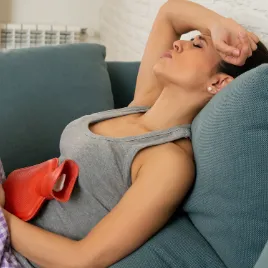
Published on: 6 April, 2021
Read Time: 6 min
Endometriosis is a largely misunderstood and misrepresented women’s health condition. It is believed to affect 1 in 10 women around the world during their reproductive years. It can be difficult to diagnose as the symptoms vary significantly from woman to woman.
For some women, the pain can be excruciating, while for others the discomfort starts off minor and gets worse with age. Because many of the symptoms of endometriosis can mimic more severe symptoms of a woman’s menstrual cycle, it can be difficult to make a definitive diagnosis at first.
“A definitive diagnosis is made by surgical evaluation (Laparoscopy) and biopsy of the lesion of concern. A presumptive diagnosis can be made by clinical signs and symptoms in low risk, early cases.” – Emily Boyd, MD
What is Endometriosis?
Endometriosis is characterized by intense pain, particularly during a woman’s menstrual cycle, that is caused by endometrial tissue that grows outside of the uterus. While this tissue normally only grows inside the uterus, with endometriosis it invades the other reproductive organs such as the ovaries, fallopian tubes, and pelvic tissues. In some rare cases, it can even spread to other organs.
Over time, these fibroids cause scar tissue and adhesions to form which can cause the tissue layers of organs to attach to each other causing severe pain. Typically, a woman will only feel these symptoms during their menstrual cycle. This is due to additional pain and bleeding caused by the fibroids both inside and outside the uterus.
Some symptoms of endometriosis include:
- Lower back pain
- Abdominal pain
- Excessive bleeding
- Bleeding between periods
- Difficulty getting pregnant
- Fatigue
- Diarrhea or constipation
- Bloating
- Nausea
As you can see, it can be a difficult condition to diagnose due to the wide range of symptoms.
“It is difficult to “know”. Painful menstruation, pelvic pain, pain with intercourse, difficulty with bladder and bowels are some common symptoms to be discussed with your provider”. – Emily Boyd, MD
Can Endometriosis be cured?
It can be difficult to completely cure endometriosis, particularly if the condition has gone undiagnosed for a long period of time and has been growing unchecked. It is imperative to see your health care provider for your regularly scheduled checkups, as early detection and intervention can make a significant difference in your treatment options.
If caught early, more conservative treatment methods may be used such as over-the-counter pain medications and hormone therapy. For more severe symptoms, or in cases where fertility is a concern, laparoscopic surgery may be performed to remove some of the fibrous tissue.
“Some women choose, as a last resort, to have a hysterectomy. However, this does not guarantee complete pain relief. If you opt for a hysterectomy, it is important that all Endometriosis is removed at the same time.” – Elisabeth Beyer Nolen, MD
What causes Endometriosis?
There are a number of risk factors that can contribute to a woman’s chance of developing endometriosis including:
- Never giving birth
- Starting your period at an early age
- Going through menopause at an older age
- Short menstrual cycles — for instance, less than 27 days
- Heavy menstrual periods that last longer than seven days
- Having higher levels of estrogen in your body
- Low body mass index
- One or more relatives (mother, aunt, or sister) with endometriosis
- Any medical condition that prevents the normal passage of menstrual flow out of the body
- Reproductive tract abnormalities
Endometriosis can also be inherited.
“However, inherited endometriosis accounts for only about 5-7% of all cases.” – Elisabeth Beyer Nolen, MD
Does Endometriosis affect your sex life?
“Some women with endometriosis will have pain during sex (dyspareunia) or other times of their cycle that makes desire and intercourse uncomfortable. Women who have endometriosis, that is deep, often present with pain during sex.
Dyspareunia can occur when the endometrial cells attach to the supportive structures around the uterus and ovaries, near, in, or behind the cervix, or near the rectal wall. Some women can also get endometriosis on their inner abdominal wall, further making touch more uncomfortable.
Unfortunately, patients with dyspareunia are about five times more at risk of a higher stage of the condition. The experience of dyspareunia is a significant factor in relationships and quality of life. It may take a little time to see what helps each woman with dyspareunia.
Some women report that the hormonal treatments reduce the pain but have side effects such as vaginal dryness, reduced sexual desire, and weight gain. An open conversation with your health care provider can lead to improvement in symptoms and reduce sex life impacts.” – Jane Vesel, CNM
Can Endometriosis be prevented?
“Although there is no way to totally prevent endometriosis, you may be able to lower your chances of getting the condition and to manage your symptoms if you get it.
Women with high intakes of beef or other red meat or ham have higher incidences of endometriosis. Try eating more whole grains, citrus fruits, and vegetables: One study reported a lower incidence of endometriosis in women with high intake of whole grains, green vegetables, and fruit. These foods are packed with dietary fiber that helps reduce estrogen concentration in the body.
In addition, limit excessive alcohol intake, as large amounts of alcohol raise estrogen levels. Regular exercise and maintaining a healthy weight can also boost your levels of “good” estrogen metabolites (compounds that are made when estrogens break down in the body) and lower your levels of “bad” ones.
If using birth control, consider using hormones with the lowest estrogen levels. Some studies also show low trans-fat diets, and more omega-3 fats (found in fish, walnuts, and flax), can reduce period cramping and inflammation.
In one study, women who consumed the highest omega-3 fats were 22% less likely to have endometriosis. Take your time to experiment with the tips above and find an approach that is right for you.” – Jane Vesel, CNM
Summary
Although endometriosis is a serious and painful health condition, if caught early the symptoms can be managed and treated with early intervention. It is important to keep an open dialogue with your health care provider. Please be sure to mention any changes in your body, menstrual cycle, or symptoms during your visit.





